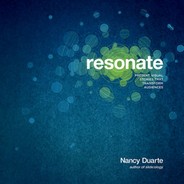
222 Resonate
Classical music includes a structure called the sonata form,
which is similar to the presentation form. A sonata has
standard “rules” to follow, yet each sonata sounds unique.
Sonatas don’t come across as contrived or formulaic, and
we can draw inspiration for our presentations from that.
Structure in the Three-Part Sonata Form
Structure enables listeners to anticipate what comes next.
The sonata form has three parts:
q
Beginning (exposition): Musical themes are introduced
and usually repeated so the listener can identify the
central musical idea. It’s important that the listeners
thoroughly understand the initial theme, so they can
recognize it when it’s modified (creating an identifi-
able gap between what is and what could be).
w
Middle (development): The musical theme is altered
and riffed off of. This is the most exciting part of the
piece, because the listeners are intrigued by how the
composer modifies the central idea. The listeners can
hear the tension between what the theme was in the
beginning and what it has become during the devel-
opment. There is an element of surprise.
e
End (recapitulation): After the ideas are modified in
the development section, the piece transitions back
to the original theme. There is a special feeling when
that theme is restated after its modification during
the development section.
Case Study: Wolfgang Amadeus Mozart
Be Flexible Within the Form
Contrast Keeps Things Interesting
Contrast keeps a presentation interesting. The same
is true with music.
r
Tonal contrast: Put simply, tonal contrast is key changes.
Ben Zander mentions in his presentation (page 48)
that music has a “home” or place of resolution for
which it longs. That home is the tonic key. The beauty
of harmony is that the human ear recognizes when we
are away from home and when we are home.
t
Dynamic contrast: Dynamic contrast is created when
the music alternates between loud and soft. Sometimes
the transition is sudden, while other times it is gradual.
y
Textural contrast:
a. Polyphony/Monophony—Throughout the piece there is
always a clear melodic line. Sometimes all the instruments
play the same melody in unison (monophony), and other
times one instrument plays the melody while the others
complement and accompany the melody (polyphony).
b. Density—The number of notes played per measure
determines the density. Sometimes there are only a few
notes per measure, while at other times there are many,
often being played at the same time.
The foundation for an interesting sonata is that it has
contrast in varying layers, similar to a presentation. Just
like a great sonata, a great presentation should follow
the structure of the presentation form yet be flexible
within its constraint. As the composer of your presenta-
tion, you need to create dramatic contrast to keep the
audience’s interest piqued.
Sonata Form
1
EXPOSITION DEVELOPMENT RECAPITULATION
ABA
Tonic Dominant Tonic Tonic Tonic
bac baca b c
Foreign KeysDominant
Each of the numbered
items in blue circles above is
represented in the sparkline
on the following pages.
CH010.indd 222CH010.indd 222 8/16/10 7:42:11 PM8/16/10 7:42:11 PM

Wolfgang Amadeus Mozart
Austrian Composer
CH010.indd 223CH010.indd 223 8/16/10 7:42:19 PM8/16/10 7:42:19 PM
..................Content has been hidden....................
You can't read the all page of ebook, please click here login for view all page.
